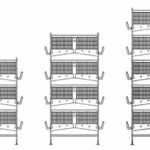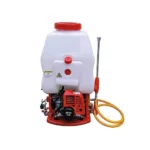The first edition of our online training for May held on the 15th of May 2020. It was a success as we had a highly informative session with our facilitator on the systems and methods to profitable crop production.
This extract is for everyone who is approaching agriculture from a business perspective. That is, those that are interested in producing crops not out of sentiment, but for profit. But before we go into the details of the training, meet the facilitator.
Facilitator: Ron Yemi Omotunde, Director, Ron Boarnergers Company; Principal Consultant at Mel Mellis Farms Resources
Ron Yemi Omotunde is an agronomist by training, a serial entrepreneur and a mathematician reputed to have a keen analytical mind. He started his business endeavours as early as age ten with Snack retail, Crafts and cards then moved on to owning a driving school, barbing salon, telecoms retail, traditional fast food, to mention just a few.
He is the director of Ron Boanergers Company, a company he started in 2010 and operated in partnership with 9Mobile to deliver telecommunication solutions. After the eight-year project, the company now offers logistic support to small and medium scale businesses, academic institutions, non-profit organizations and religious organizations.
He is also the principal consultant at Mel Mellis Farm Resources, an agricultural company delivering essential solutions in farm establishment, farm management, farm system development and deployment, and other agriculture-related investments since 2004.
He has consulted for individuals, private companies, multinationals, and universities.
Mr. Omotunde is currently building an AGRIC investment platform. The project expects to cover over 30,000 hectares in different locations. Both companies operate in partnership with the Federal Ministry of Finance through the Youwin Initiative.
His company RBC won an award of excellence and distinction, by the Federal Ministry of Industry Trades and Investments, SMEDAN and Friends Africa in 2014.
He is the president of Akobo Ibadan Fruitful Vine Farmers Multipurpose Cooperative Society Ltd, stringing like minds to achieve grand impact in the agricultural sector of Nigeria.
He serves as an executive of the Driving School Association of Nigeria, Oyo State chapter.
He is a business coach and mentor to many. He served as a volunteer facilitator for Leap Africa on youth development for three consecutive years. He speaks in different conferences and seminars where he teaches principles on business growth, negotiation, budgeting, and kingdom finance.
Mr Omotunde is happily married to Mosunmola, and they have two adorable daughters, EbunoluwaJuwura and OluwaseunBabaralayemi.
Sharing from his personal experiences in the field, Mr. Omotunde trained us on Profitable Crop Production: Systems and Methods in the following highlights;
Training highlights:
- Profitability in Crop Production
- Fundamental things to Consider in Crop Production
- Choices that affect profitability in Crop Production
- FAQs in Crop Production
- Conclusion
Profitability in Crop Production
There are two ways to make a profit. One way is to reduce cost. For instance, if you’re to sell a ton of maize for N95,000, to increase your gain, you must ensure that your production cost does not go beyond N50,000.
Another way is to increase the ton or weight that you can produce. So, maybe you are meant to cultivate 10 acres before and then you decide to increase to 20 acres. As you increase the volume of production, you are going to increase your cost.
In general, take for instance, if you want to farm in 2020, the best time to start preparing for the farming season is the end of 2019 farming season, that’s around October or November. However, as that season ends, you must have decided what and where you want to cultivate, taking into consideration some basic things to ensure your profit is significant in your crop production.
Fundamental Things to Consider in Crop Production

Farm Location
In choosing your farm site, you must have found out what the weather pattern and climatic condition of the farm area. You must consider the distance and road network because this will add to your cost one way or another. The availability of workers is vital in selecting your farm site, principally if you’re producing on a large scale.
For instance, if you are producing maize, you need help with harvesting, fertilizer application etc. So, whatever it is you want to cultivate, you find out if workers will be available locally. Because, if workers are not available locally, what that means is that you will have to import workers. So, the cost of transporting workers will add significantly to your production cost. Therefore, you need to find out all those things before you decide on using a particular location.
Crop Selection
Based on peculiarities, there different categories of crops that can be grown in Nigeria. These are;
- Root and tuber crops (Yam, Cassava, Potatoes etc.)
- Fruits and vegetables (Watermelon, Cucumber, Carrots, Okro, Amaranthus etc.)
- Cereals (Maize, Sorghum, Millet etc.)
- Legumes (Soybean, Cowpea (beans) etc.)
- Tree crops (Oil palm, Cashew, Cocoa, Rubber etc.)
- Wood crops (Teak, Melina etc.)
If you’re a startup or new to the agricultural space, my advice is that never plant what you cannot store. If you produce something that is highly perishable, you may be unable to market it, probably because you didn’t do your market analysis properly. After that production matures, it begins to drive towards decay. Go for the crops such as maize, soybean, yam etc. that you can store, even if it’s for a few weeks or month.

Now, if you want to plant anything, before you buy your buy seeds, ask yourself if that is how much you are going to spend before you make a certain amount of profit. That always considers what the input will be that will give you a particular output.
Also, the particular crop you want to grow such as potatoes, yam, maize, legumes, soybean, cowpea, root and tuber crops etc. should be chosen based on the market you want to serve. You must be sure that there is a market for your product. I see a lot of people say they want to go into cassava production, not because they have a ready market for it but because they heard that cassava sells.
You must have decided exactly what you want to produce before you start your production. So, your crop selection should be based on a market that you are sure it exists.
Market Survey
You must have done your research to find out where the market is, what the cost of the produce is in the market, and what the average production cost is, by talking to people who are already producing. Research and find out what the production cost would be and what the transportation cost would be from your farm to the market.
Now, the market does not mean an open market. It could mean that you are supplying a supermarket, a food outlet. Make sure you find out the cost of transportation.
Land Preparing
Usually, this depends on the size of farm you want to use for production. If you’re producing on a large scale, your land preparation must start just by the end of last planting season. If you’re opening up a fallow land, then your felling/bulldozing should be done at the start of November until the end of the first few months in the following year, just by the end of the last planting season.
In preparing your land for production, there are different options you can choose from, these are;
Bulldozing
Using a bulldozer for land clearing will involve an average cost for the daily job operation, including the operator’s allowance and cost of diesel. Depending on where your farm is, you will pay an additional price in transporting the dozer to and fro. On average, a dozer will clear about 3 acres per day, based on the tree density of that land.
After this first stage of the clearing, you will have a few roots and stumps left. You will then have to hire labourers to clear them for you.

Stumping
Stumping requires getting labourers to remove the trees from the root. Usually, it takes more time and could be cheaper or more expensive. The first operation is to uproot, then stump, cut into small trunks, and then get labourers to carry them out for burning or something else.
Now, if you’re going to choose this option, you must have started since September because it will take you a long time before you can acquire significant space.
Whichever option you are going to choose, you should factor the price into it. Now, when you’re doing your financial analysis, you don’t have to re-quote the cost of cultivating that year. For instance, if you spend 2 million or 3 million Naira opening the land, you won’t expect to make that back that same year. You will depreciate that over 10, 15, or 20 years once you clear the land, as long as you use it annually. So, you should consider the cost of your land preparation.
Although, there are claims that the use of a dozer destroys the soil structure or push up the topsoil. Those claims are valid, but not entirely true. You can use a bulldozer, and the topsoil will still be conserved. Whatever works for you, you can either use a bulldozer or manual labourer. But you should consider the cost and speed at which you want the job done. If you want the job done with 2 to 3 weeks, you have to use a dozer. If you don’t mind for the work to spread over 4 or 5 months, you can use local workers.
Decisions That Can Hinder Profitability in Crop Production
Practising Short-Term Production
If you are going into agribusiness, you need to ask yourself whether you are doing it as a short-term business or for the long run. This question will help you make vital decisions. However, know that there is nothing like short term business in agriculture. For instance, if anyone tells you that by investing in maize production, you will get 70% in six months. It is not advisable to put your money into such because you are going to lose that money.
Leasing a Land for Production
When choosing your farm location, it is better to own the land than to lease it if you will be profitable. For instance, if you invest with a certain amount to buy and clear a piece of land, and after you cultivated your arable crops and at the end of the season, after selling your crops, you realize your revenue was less than your cost of production. The truth is that you have not lost anything because the land is still there and the clearing that you have done is still there. So, even if you didn’t make a profit, you can come back to that same land without paying anybody and you can reestablish something on that land.
However, if you lease a government or an existing land for 2 years or three years, and then you go there, do some clearing, planted something and maybe something goes wrong and you become discouraged. The year after that you don’t even go to the farm at all. Then the third year you come back and you find out that your lease has expired. So, you are back to square one. Therefore, it is better to own the land than to lease the land.
Linear Crop Production
Choosing to produce just one crop can hinder you from breaking even eventually when you sell. So, find out how you can integrate other crops into what you are doing. That way, you will make some money from one and then hit into profit from the other.
If you are producing on a large expanse of land, perhaps mainly arable crops like maize or cassava, you should add tree crops to it. This is because if you planted maize and you didn’t make so much money but you have either cashew or oil palm. The oil palm is still there, you cannot say what you’ve done is an outright loss. Because, by the next year, your oil palm or your cashew is a year old, so, you are getting close to getting something from that aspect that you invested in.
Agricultural Insurance
Now, when things going wrong on your farm, you need to understand that there is agricultural insurance. We have two companies in Nigeria that provide insurance for agricultural investment, NAIC and Leadway.
Insurance does not cover your negligence or any technical failure on your part. What they are insuring, of course, are things beyond your control, such as fire incidence. So, there is insurance to cover for your investment, but you need to also have technical knowledge and competence.
Agriculture and Technology

In technology-based agriculture, you need to be extremely careful. Where these technologies come from, there is always a need for it. The first thing we should ask is, what is this technology trying to solve? Do I have that problem? Is it my reality or context? If it is not, then the technology might not be for you yet.
For example, Recirculating System in fish farming came from countries where getting adequate water and space was a challenge. So, the technology was invented to solve the problem of water and space.
The same applies in Vertical crop farming system, where you plant in layers on a smaller space. I don’t have the problem of space, you do not have to use a technology that might be difficult for you to handle or operate.
Also, some people have lost their investment in trying to raise crops like vegetable and tomatoes in greenhouses. The technology and support they need to operate that system may not be readily available.
Of course, you should embrace technology you cannot be farming at the level of hoe and cutlasses. But whatever technology that you want to embrace, consider your need for it as well as the support that might be required to run that level of technology.
FAQs in Crop Production
When is the best time to start preparing the land for planting season?
Start just by the end of the last planting season.
What is the purpose of harrowing and ridging?
You can either plant your crops on flat, low heaps, or you plough or harrow on level ground. But when you plough, you till the land, you make it soft for the root to penetrate. And harrowing simply makes the land level.
For instance, if you plant maize on just a ploughed land, some of the maize seeds will be planted in gullies, in the lower part, and usually, they don’t do well. Those planted on the higher part do better. Because it is a large expanse of land, some of it will fall in those deep parts, some of it in trenches, or gullies or on heaps.
The ones on the heaps do better. Anytime it rains, and you have puddles of water in those lower points, it will destroy the other ones that are growing there. So, if you are planting maize, usually, if the person who ploughs for you can plough and makes sure that the soil is well covered and it’s as flat as possible, it will help increase your yield.
Now, ridging usually is done for tuber crops, except for vegetable production and sometimes maize. But if you plant maize and soya on ridges, what you will notice is that the inter-row spacing will be wider than if you plant on flat. So, for instance, if you’re planting maize on flat, you can have like 75cm inter-row, 25cm intra-row, depending on the density you’re trying to achieve.
If you’re planting on ridges, you can find out that the distance of the ridges can be like twice or 2 and a half that distance. So, it reduces your plant population per stand. But ridging is to help improve your crop performance.
Is it compulsory to plough before planting or what would be the likely percentage loss on return if you don’t plough?

There is something that is called zero tillage, though not sure it is very common. Zero tillage is when you do not work the soil at all before you plant. For instance, in zero tillage, you can either use herbicide on the existing weed or slash manually before spraying herbicides and then when the weed gets burnt, you plant either the maize or soya you want to cultivate. Once the weed starts sprouting again, you use a hoe and then zero tillage. Some do it while others simply work the soil using a tractor.
I just acquire 10 acres of land, how do I get the land ready for planting.
Start just by the end of last planting season.
How many crops can one plant together on land?
It depends on the kinds of crops you want to produce. For instance, some crops are shallow feeders, while others are deep feeders. Some are nitrogen-fixing plants, like legumes, e.g. groundnut, soybean, cowpea. Usually, if you want to inter-crop, you plant deep feeders with shallow feeders. For example, you plant maize with soybean, maize with cowpea, maize with groundnut; or maize with cassava etc. Yes, you can plant more than one crop on a particular land, but of course, you have to know the dynamics of intercropping so that you can maximize it.
What are the best herbicides in Nigeria?
There are different types of herbicides. Predominantly, we have Glyphosate that can come in any brand (e.g. Forceup), Paraquat etc.. Whatever crop you are cultivating, especially if you are a novice, it is advisable you work with an extension worker, or you look for somebody who knows about it that can mentor you or you have a consultant.
Does one need to put fertilizer after planting?
Yes, depending on your crop. If you are producing maize, for instance, you need to apply fertilizer. Of course, there are two types of fertilizer, we have the organic fertilizer and the inorganic fertilizer. Also, we have liquid fertilizer that you can use for vegetables.
Is spraying herbicides more profitable than the use of hoe in removing weeds?
It depends on the size of the land. If you’re dealing with large scale production, maybe hundreds of hectares, you may not be able to hoe. So, you may be forced to use herbicides. But if you can afford to hoe, yes you can use it if the scale is smaller. But if not, herbicides may just get the job done.
When is the best time of the year to plant yam?
Usually, heaping for yam starts September /October. The actual planting is usually done towards the end of the year, around December or early January.
Conclusion
In summary, to maximize profit in crop production, you need to consider long term investment and have a structure, a business plan.
Also, except you have a contract, or you are producing to supply a guaranteed market like a supermarket or an eatery, grocery store, or to your client base that will offtake, it is not advisable to produce perishables like fruits and vegetables for the open market. Instead, you may produce tree crops like cashew, oil palm, cocoa, though they may take a while before you start reaping your profit, long-lasting once established.
You can even produce other crops like maize, cassava and the likes along with it and at the end of every season, you have guaranteed income from your tree crop plantation. When you have that leverage, you can now begin to experiment with perishables.
For instance, if you have a hundred acres land, you may not be able to open the whole 100 acres at once. The first year, you can open 25 or 30 acres, cultivate it, establish your tree crop. Do the same the second and third year. By the end of the fourth year, you have a fully opened and established 100 acres and then you have your crops in different ages. You might not be able to achieve everything at once but definitely will have something to show for in a few years
Question

Question: “What is the typical bottom-line assumable ROI of 5milion naira in 3years and 6 months for an average crop?”- Scdnnaji
Response: If you’re investing with an existing agricultural organization or a farm, I will tell you that the most reasonable annual ROI currently in Nigeria is 20%. There’s a difference between partnership and investment. If you are going into partnership with somebody else, the person might be able to give you a higher return on the amount of money you are bringing in. Remember that in partnership, you are both sharing risks, and you are both sharing profit.
So, if the business makes a profit, you share the profit on an agreed percentage. If the business makes a loss, you are both going to bear the loss. But if you are the one investing the 5 million yourself, what you are putting the money into will determining how much you can make on that investment. Remember, if you are buying land and clearing it out of the 5 million and you won’t make that back again within 3 and a half years. You are going to use the land progressively as you cultivate and as you farm. It depends exactly on what you are farming. But if you are investing with an existing farmer, 20% is not reasonable. Anything that is on the high side, I don’t think the person will be able to perform on it.
Question: “What do you think of recycling “waste” to use in agriculture?”- Bim Bim
Response: If there is a way that you can recycle any kind of waste and it can add value to the agricultural space, you can go ahead. But again, make sure that the product that you are trying to bring to the table is something that offers real value. For example, you can recycle plastic or nylon polyethene bags as nursery bags for people who establish a plantation. I think it’s a noble enterprise. because not everybody will have to go into crop production. You can go into a line of business that services those that are into production.
For instance, you can do equipment hiring or commodity sale where you can buy from those that are into production, and then you can either store till when the product is scarce and sell. These are some of the things that you can do which are not directly in the line of production but it is still somewhere along the value chain, getting the produce between the manufacturer and the consumer. So, whatever innovation you can bring into the industry I think it is welcome.
Question: “When does someone start the market, is it before planting or when?” – Da_Christy
Response: You need to start your marketing before you plant. This means you must know the market that you want to sell that product to, not the general open market, but knowing exactly who is going to buy from you. If you do that it is a better arrangement, and things are much more definite. Except for produce that has a fixed market price that you know that no matter what happens, you won’t sell below the price.
So, whatever you are producing, it’s usually better if you already have an idea of where your product is going, how much will be collected, the quality that they want and the likes, so that you can factor them into your production. When you have an idea of the average cost, you can use that to work on your cost of production to ensure that there’s a reasonable margin. So, I advise that you have a market before you start production.
Question: “How do you quantify or label a price on your labour? For instance, I go to the farm and plant vegetables myself, how do I quantify my time and labour, as my time should also yield profit?” – Bim Bim
Response: There must be a way you can quantify your input and there are different ways to it. If you are a high capacity person, your one hour may not be equal to a labourer’s one hour. So, there’s something that they call man-day, woman-day or boy-day in agriculture. So, you can say, it will need two man-days to do this, it would need two boy day to do that. And there’s a price for each. Man-day could be 2000 Naira, woman-day could be 1500 naira, and a boy-day could be 1000 naira. So, even if you do all these things yourself, you need to factor that into your production cost. And when you sell, you deduct all that before you know if you have made a profit or not.

Question: “What do you think about a system of crop production where we have to use natural methods in the cause of production. Starting from cultivation to harvest. What are the measures to be taken and how can awareness be created on this?”- Os_ farms
Response: Natural methods as in organic farming is all about the no or minimal use of chemicals, like herbicides, insecticides, fertilizer etc. Now, what you need to understand is that if you are producing these kinds of products, you cannot afford to sell into a general market. So, if you are doing this kind of farming, what that means is that you must have people that value organic farming and then those are the kind of people that your customers would be like old people.
So, you mustn’t just cultivate crops out of sentiment because you like organic farming and you don’t like chemicals and then take your product to an open market. There you won’t have a price that will keep you in profit because you can’t sell at the same price as inorganic farmers. So, there’s nothing wrong with organic farming, but you need to have a market for that kind of product.
Question: “What is the minimum size of land to start commercial farming. Also, what type of crop is advisable for beginners to start farming in term of challenges?”- Halleluyah
Response: The answer to this question depends on your vision and some other factors. What do you see? What you want and how much do you have? Do you have the money to invest? What do you want to do? For instance, if you are doing arable, maybe arable greens, fruits or vegetables, 50 acres of land will be a relatively big farm, especially if it is not a technology-based farm, but open field cultivation. But for tree crops, 50 acres is not a big farm. To answer the second question, as explained earlier, you should try as much as possible to cultivate crops that have easier agronomic practices and those that can be stored after production. So, as a beginner, avoid investing your money into perishables.
Question: “I want to ask if there is a ready open market for crops in Nigeria and if yes, how can one access or contact it.”- Halleluyah
Response: Agriculture thrives on population, so as long as you see people, you are looking at opportunities because people will eat. There are different types of crops, you have crops that can be consumed by people directly and crops that have industrial value, that goes through industrial processing before it can be used. To answer your question, yes there is a market. But you need to research on market trends and patterns. Also, you may need to network and collaborate with those who are already in the business, that can assist and show you how you can go about it as well as link you to buyers in the market.














One thought on “Profitable Crop Production: Systems and Methods”
Very good advices and interesting